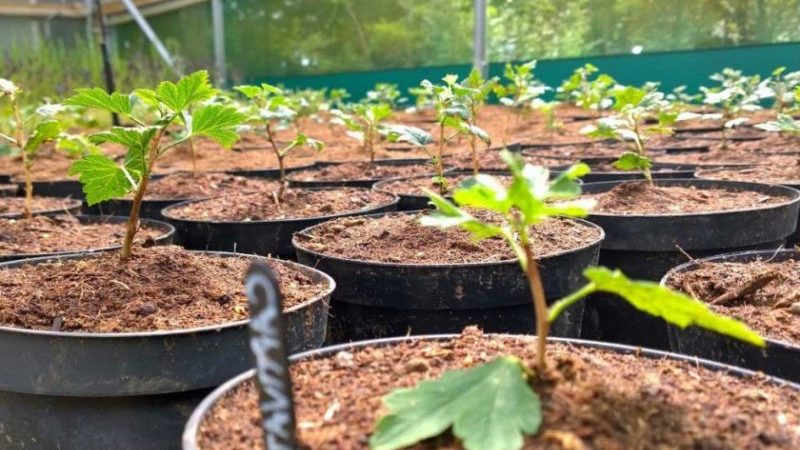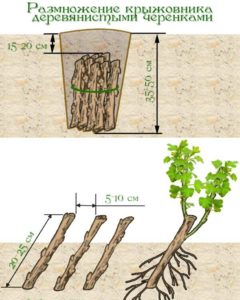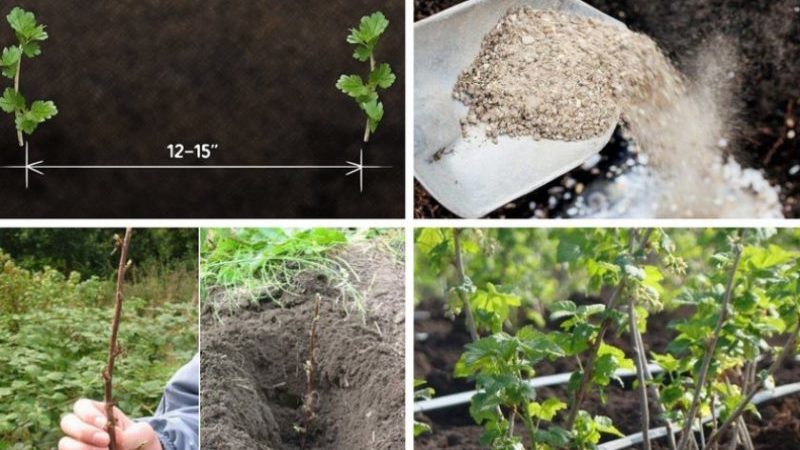How to properly propagate gooseberries in summer by cuttings: a step-by-step guide
Propagation of gooseberries by cuttings is a quick and least costly way to increase the number of bushes in your garden plot. The berry culture is renewed every 5 years. To obtain young bushes, green, lignified and combined parts of the plant are used. Consider how to properly propagate gooseberries by cuttings in the summer.
The content of the article
Features of gooseberry propagation by cuttings in summer

Gooseberries are propagated throughout the warm season. Summer cuttings are one of the best options.
To do this, choose fruitful hybrid bushes not affected by diseases. Take into account their age, the rate of growth of shoots and the planned number seedlings... The main conditions for the successful cultivation of a young bush are a sufficient amount of heat, moisture and fertile soil. Only if these parameters are observed, the roots of the plant are actively formed.
Advantages and disadvantages
The preservation of the qualities inherent in the mother bush is an indisputable advantage of propagating gooseberries by cuttings. If the procedure was carried out using green material, even if the aerial part dies due to the harsh winter conditions, the plants will quickly restore it from the root system.
The disadvantages of this method of grafting:
- lack of time for the roots to ripen before the onset of cold weather;
- the absence of a taproot and, as a consequence, the requirement for watering;
- later entry into the fruiting stage.
Differences from the procedure in spring and autumn
If in the summer the most acceptable method of propagation is cuttings, then in the spring and autumn it is preferable to use other methods. After winter, it is better to propagate gooseberries by layering: before the start of sap flow, this method will be the least traumatic for the mother bush. It is also important to do this before the start of the growing season. In the fall, it is already allowed to carry out cuttings, but lignified material is used for this.
Reference. The timing of cuttings in summer is limited by the end of the growth period of the shoots, when they stop lengthening and lose elasticity.
In autumn and in spring the bush is propagated by separating a perennial branch from it. The procedure is carried out after the end of leaf fall or before the buds swell.
Preparatory stage
This laborious but interesting method is associated with mechanical damage to the aerial part of the bush. Therefore, it is important to prepare quality tools and disinfectants.
Rooting conditions
So that the work on the propagation of gooseberries does not end with the death of the planting material, it is important to strictly observe all the conditions and sequence of the procedure.
For successful rooting of cuttings, you need:
- air temperature not lower than + 20 ... + 25 ° C;
- high humidity and good air permeability of the soil;
- soil temperature 5 ° C higher than ambient temperature;
- high-quality lighting;
- optimal concentration of cambium and nutrients in the planting material;
- saturation of the soil with growth stimulants.
To increase the content of nutrients and cambium, the mother bush is fed with potash and phosphorus fertilizers for 1.5 months. This is done every 3 weeks. For 1 bush, 10 liters of water are used, in which 15 g of potash and 20 g of phosphorus fertilizers are diluted.14 days before the separation, the shoot is pinched in the lower part with a wire.
Soil preparation
The berry bush prefers loose and nutritious soil. Before planting it, all perennial weeds are carefully removed on the site.
Advice! Experienced gardeners plant dahlias in this soil a year before gooseberries. They clean the soil and loosen it up.
Clay, sandy, peat soils are suitable for gooseberries.
After harvesting dahlias in the fall, they reduce the acidity of the soil by adding dolomite flour to it. Gooseberries are suitable for low or neutral pH.
What cuttings to use

Green cuttings are due to the biological feature of plants - regeneration. Such seedlings develop strong and fibrous roots, which grow 85% more than shrubs obtained by breeding lignified shoots. The former are 60% longer than the latter. For cuttings with green shoots, young shoots that have appeared on the bush in the current season are suitable.
Lignified cuttings are less reliable than green cuttings. The older the shoot, the lower the chances of its successful establishment.
Combined cuttings for propagation of gooseberries are used in the spring, when the shoots of the current year will grow by 10-15 cm. Green shoots with a part of last year's wood are rooted immediately in the open field.
How to root
There are 2 ways to root gooseberries: in water and in soil.
In water
This method is suitable for rooting lignified gooseberry cuttings. For the procedure, use soft melt or rainwater, purified from impurities and salts. Sequencing:
- Shoots taken from the mother plant up to 25 cm in length are cut in the upper and lower parts at a distance of 2 cm from the lower bud.
- The material is disinfected with a bactericidal solution and placed in water so that the ends of the cuttings are immersed above the lower kidney.
- The shoots are covered with a bag.
- When the first roots and green mass appear, the material is transferred to a previously prepared soil, while providing air access.
For faster growth, the slices are treated with a growth stimulator for a day, then washed and again dipped in clean water.
In the ground
Green cuttings are planted in the ground throughout July. There is no need to procure material in advance. It is rational to cut the shoots right on the day of planting. Roots are formed on cuttings in a trench without using boxes.
The cuttings must be fresh. Before transferring to the ground, the material is kept in warm water for up to 5 hours. The lower part is deepened obliquely into moist soil, compacted around the trunk and watered.
How to properly propagate gooseberries by cuttings

How to grow gooseberries from green cuttings:
- In early July, cuttings 15 cm long are cut from the upper branches of the bush.
- There should be about 8 leaves on the shoot.
- Its lower third is immersed in water mixed with a growth stimulant and kept for up to 5 hours.
- How to plant cuttings? They are transferred to the fertile soil of the greenhouse, buried 3 cm. Distance between planting material stand at 5-7 cm.
- Water the shoots thoroughly.
- After 2 weeks, liquid nitrogen fertilizers are applied.
- For the winter, plants are covered, like all berry crops.
- Cutting ends in spring, when young plants are transferred to a permanent place.
Propagation by lignified cuttings:
- Cuttings are cut from the aged shoots of the current season. Their length is 20 cm.
- Tied in a bundle of 10–20 pieces and wrapped in a piece of cloth without overtightening.
- They are placed vertically in a container with a mixture of peat and sand, falling asleep on top with a layer of up to 20 cm. The composition is moistened.
- The cuttings are stored for about 1 month at above-zero temperature, periodically moisturizing. During this time, peculiar seals appear at the ends of the shoots.
- After a month, they are separated, sprinkled with wet sawdust and left until spring.
- When suitable weather conditions occur, they are planted at an inclination at a distance of up to 10 cm from each other, leaving 3 buds above the ground.
- In autumn, young gooseberries are planted to a permanent place.
Combined cuttings are cut with a small lignified shoot from last year. To accelerate growth, a stimulant is added to the irrigation liquid, and the sprouts are mulched.
If all conditions are strictly observed, the roots are formed already at 2 weeks.
Mistakes to Avoid
In pursuit of a faster engraftment of gooseberries and an increase in the future yield, some gardeners apply too much mineral fertilizers and manure. The former will interfere with the rooting of young plants, and the latter will cause burns on the underground part of the bush.
Important! Cuttings should not be planted in soil where wheatgrass grows. Such a neighborhood will destroy young plants.
A site with a close groundwater table is not suitable for planting gooseberries. Their optimal level is 1.5 m. It makes no sense to take skeletal gooseberry branches for cuttings - they will not develop a root system.
Further care

After rooting cuttings in the summer, it is important to properly care for them. For moisture-loving gooseberries, it is advisable to install an aeration system, especially when the dry period begins.
Watering is carried out as the upper layers of the soil dry out. For each young bush, they consume from 3 to 5 liters of water.
To successfully form the root system, on the 3rd day after transfer to the open ground, the cuttings are watered with succinic acid (0.2 g of dry matter and 1 liter of water per plant). After 2 weeks, complex fertilizers are applied.
Conclusion
Gooseberries are propagated by cuttings in spring, summer and autumn. The most viable bushes grow from green material that is prepared, processed and planted in July. Clearing the area for young seedlings, observing the conditions for their rooting will lead to the fact that the gooseberry will be ready for fruiting already in the next season.